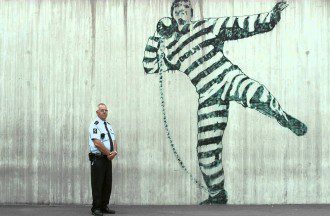Contributing writer for Wake Up World
“Every inmate in a Norwegian prison is going back to the society. Do you want people who are angry — or people who are rehabilitated?” ~ Are Hoidel, Director of Norway’s Halden Prison.
Outrage over an ABC News ‘Four Corners’ report on child torture at Australia’s Don Dale Youth Detention Centre has prompted community members to demand change to the current “justice” system. Violent footage showed “children being stripped naked, choked, and put into hooded full-body restraints resembling torture devices reserved only for the world’s most dangerous criminals.” Some were as young as 11-years-old.
The U.S. doesn’t fare much better with its detention centers and prisons — overcrowded and rampant with violence, they’re the equivalent of modern-day slave ships where inmates can earn as low as $0.23 per hour producing consumer goods for corporations. We may think this is the “way of the world” and that not much can be done about the situation overall — until we learn about the extraordinarily civilized, and effective, prison system used in Scandinavia.
A Revolutionary Model
While the typical prison in the U.S. relies heavily on concrete, coils of razor wire, barren land free of any trees or plant life and lethal electric fences, along with towers manned by snipers, a maximum security correctional facility two hours north of Oslo, Norway has stunned Americans. Regarded as the world’s most humane prison, Halden is a maximum security facility filled with rapists, murderers, pedophiles and drug offenders. And yet, the compound is a far cry from what we would expect such a prison to be.
“In the choice of materials, the architects were inspired by the sober palette of the trees, mosses and bedrock all around; the primary building element is kiln-fired brick, blackened with some of the original red showing through. The architects used silvery galvanized-steel panels as a “hard” material to represent detention, and untreated larch wood, a low-maintenance species that weathers from taupe to soft gray, as a “soft” material associated with rehabilitation and growth.” ~ Jessica Benko of the New York Times describing Norway’s Halden Prison
Each inmate has their own room, complete with flat screen television, bathroom, mini-fridge — and no bars on the windows. There’s a range of vocational programs like wood-working, assembly workshops and even a recording studio. Normalcy is the key, where friendships between guards and inmates are common and fully equipped kitchens are available for most to use. High-quality art peppers the complex and shared living rooms serve to “create a sense of family.” However, as important as the actual design of the facility is in reducing violence and improving rehabilitation, the security within the prison plays an exceptionally crucial role as well.
One of the main differences between the staff at Halden and a maximum security prison in the U.S. is that Norway emphasizes “dynamic security,” whereas America favors “static security”. The latter relies on remote controlled doors and surveillance cameras, an environment designed to limit vandalism or weapon-making by utilizing tamper-proof furniture, and correction officers who are trained to have very little interaction with prisoners to reduce the risk of altercation. In contrast, dynamic security is structured to prevent harmful intentions in the first place.
The officers at Halden are placed in close quarters with the inmates to support casual socialization between the two — many times over tea and coffee or meals. “The architects were instructed to make the guard stations tiny and cramped, to encourage officers to spend time in common rooms with the inmates instead,” reports the New York Times. While there are surveillance cameras on the prison grounds, inmates usually are able to move around unaccompanied by guards. Nor are there cameras in most of the workshops, classrooms, common rooms, cell hallways or the cells themselves. The inmates have ample opportunity to act out, but don’t. Halden is six-years-old and in that time, the isolation cell with a limb-restraining bed has yet to be used.
Writes Jessica Benko in The Radical Humaness of Norway’s Halden Prison:
“It is tempting to chalk up all this reasonableness to something peculiar in Norwegian socialization, some sort of civility driven core-deep into the inmates since birth, or perhaps attribute it to their racial and ethnic homogeneity as a group. But in actuality, only around three-fifths of the inmates are legal Norwegian citizens. The rest have come from more than 30 other countries (mostly in Eastern Europe, Africa and the Middle East) and speak little or no Norwegian; English is the lingua franca, a necessity for the officers to communicate with foreign prisoners.”
Interestingly, Halden is an example of one of most restrictive prisons in Scandinavia. Lower security facilities that dot the region are even more liberal with freedom, like the prison on Suomenlinna Island in Finland, which has been an “open” prison since 1971. Each of the 95 male prisoners exit the prison grounds each day to do general maintenance in the nearby town, or commute to the mainland for work or study.
Would This Model Work Elsewhere?
As revolutionary as these facilities appear, the question is whether the prison models would work in America and other countries. According to Nikola Milanovic in the Stanford Progressive, the answer is a resounding ‘no’, mainly because Scandinavian countries have a much different social structure and view of the government’s role towards its citizens.
The author notes:
“The social safety net in Norway guarantees basic minimums for members of society that might make people more complacent with such a luxurious facility. Americans, by contrast, are more culturally adapted to the ideology of rugged individualism and reaping deserved rewards: people only deserve what they can afford, the American mindset implies, and they can afford what they earn. Convicted felons, in the United States, would not merit a very high standard of treatment.”
In short, Milanovic proposes that high levels of financial and social inequality in America would leave citizens uncomfortable with establishing well-appointed prison facilities, especially when there’s significant poverty and underdevelopment throughout the country. An enormous backlash would likely ensue, even if the point was made clear that such a prison system would actually lower public costs by one-half to one-third of current prison spending in the U.S. — due to the reduction in recidivism rates. In the U.S., up to 70 percent of former convicts return to prison within a few years of release. In Norway, the number is around 20 percent.
There’s also the issue of disproportionately high incarceration rates in America. If the United States incarcerated individuals at the same modest level as Norway (a rate of 75 inmates per 100,000 population, compared to approximately 700 per 100,000 in the U.S.) and invested the same $93,000/year per inmate (versus $31,000/year in the U.S.) into the system, it would still save over $45 billion a year.
But, until the cultural mentality in the U.S. has a major overhaul, the future looks bleak for the establishment of an enlightened prison system here anytime in the near future.
Article sources
- www.nytimes.com/2015/03/29/magazine/the-radical-humaneness-of-norways-halden-prison.html?_r=0
- www.washingtonpost.com/news/worldviews/wp/2016/02/05/norway-gave-its-cops-guns-after-1-year-its-taking-them-away-what-did-it-learn
- www.mintpressnews.com/what-norway-is-getting-right-about-policing-that-american-cops-just-cant-figure-out/208413
- www.theatlantic.com/international/archive/2013/09/why-scandinavian-prisons-are-superior/279949
- www.businessinsider.com/why-norways-prison-system-is-so-successful-2014-12
- www.globalfreedommovement.org/dylan-voller-solitary-confinement-psychopaths-systemic-abuse-children
- www.web.stanford.edu/group/progressive/cgi-bin/?p=653
- www.salve.edu/sites/default/files/filesfield/documents/Incarceration_and_Recidivism.pdf [PDF]
About the author:
 Carolanne Wright enthusiastically believes if we want to see change in the world, we need to be the change. As a nutritionist, natural foods chef and wellness coach, Carolanne has encouraged others to embrace a healthy lifestyle of organic living, gratefulness and joyful orientation for over 13 years.
Carolanne Wright enthusiastically believes if we want to see change in the world, we need to be the change. As a nutritionist, natural foods chef and wellness coach, Carolanne has encouraged others to embrace a healthy lifestyle of organic living, gratefulness and joyful orientation for over 13 years.
Through her website Thrive-Living.net, she looks forward to connecting with other like-minded people from around the world who share a similar vision. You can also follow Carolanne on Facebook, Twitter and Pinterest.
Further reading from Carolanne Wright:
- The Most Eco-Friendly Nation on the Planet is Now Carbon Negative
- Plastic Waste in the Ocean Will Outnumber Fish by 2050
- Mind Control, Subliminal Messages and the Brainwashing of America
- Monsanto Charged with Crimes Against Nature and Humanity – Set to Stand Trial in 2016
- Plastic-Eating Mushroom Discovered in the Amazon Rainforest — A Solution for Our Trash Saturated World?
- Over 100 Scientific Studies Agree: Cannabis Annihilates Cancer
- Why Every Parent Should Consider Unschooling
- First U.S. City Produces More Electricity Than It Uses — With 100% Renewable Technology
- If You Care About Animals and the Earth, Here’s Why You Need to Boycott Palm Oil Immediately
- Basic Income Guarantee: A Surprisingly Cost-Effective Method for Eliminating Poverty

If you've ever found value in our articles, we'd greatly appreciate your support by purchasing Mindful Meditation Techniques for Kids - A Practical Guide for Adults to Empower Kids with the Gift of Inner Peace and Resilience for Life.
In the spirit of mindfulness, we encourage you to choose the paperback version. Delve into its pages away from screen glare and notifications, allowing yourself to fully immerse in the transformative practices within. The physical book enriches the learning process and serves as a tangible commitment to mindfulness, easily shared among family and friends.
Over the past few years, Wake Up World has faced significant online censorship, impacting our financial ability to stay online. Instead of soliciting donations, we're exploring win-win solutions with our readers to remain financially viable. Moving into book publishing, we hope to secure ongoing funds to continue our mission. With over 8,500 articles published in the past 13 years, we are committed to keeping our content free and accessible to everyone, without resorting to a paywall.







